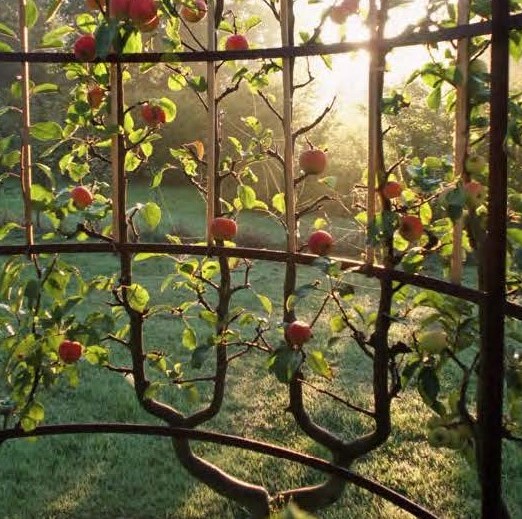En Français, on dit espalier
Dans son livre, sur la taille, The Pruning Book, The Taunton Press, 2010, Lee Reich écrit que le mot
espalier désigne une plante, généralement une plante fruitière, conduite de façon ordonnée selon forme bidimensionnelle. Le mot est dérivé du vieux français aspau, qui signifie support, et la plupart des espaliers doivent, de fait, être soutenus par des piquets ou des fils. L’espalier a connu ses débuts officiels en Europe au 16e siècle, lorsque des arbres fruitiers étaient plantés le long de murs pour profiter de la bande de terre et de la plus grande chaleur près de ces murs. Strictement parlant, un espalier cultivé sur un treillis en pleine terre est un contre-espalier ou un espalier-aéré, mais inutile de se compliquer la vie avec les mots. La définition de l’espalier est aussi peu précise que la plante est formelle.
En Anglais, on dit aussi espalier (es-pal-Yay)
Espalier (es-pal-Yay) is the training of a plant, usually a fruit plant, to an orderly, two-dimensional form. The word is derived from the Old French aspau, meaning a prop, and most espaliers must, in fact, be propped up with stakes or wires. Espalier had its formal beginnings in Europe in the 16th century, when fruit trees were trained on walls to take advantage of the strip of earth and extra warmth near those walls. Strictly speaking, an espalier grown on a trellis in open ground is a contre-espalier or an espalier-aéré, but no need to be a sticker for words. The definition of espalier is as lax as the plant is formal.
Avez vous entendu Peter Thevenot, River Road Farms, Tennessee, Etats-Unis, parler de ses espaliers ?
Quelques autres liens :
Espalier an apple tree, Chicago Botanic Garden
Espalier gardening and How to espalier? University of California Agriculture and National Resources (UNCAR)
Training a fruit tree into an espalier takes a good dash of dedication, Oregon State University
Espalier: Create Living Art with Form and Function, Nebraska Extension in Lancaster University
Perry (Ron) and Getter (Kristin) Espalier Fruit Plantings for Northern Gardens, Michigan State University, College of Agriculture and Natural Resources
Reich (Lee) Fruiting espaliers: a fusion of Art and Science, Arnoldia, 1999-2000, winter
Ingels (Chuck), Wave of the Future: Espalier for Harvest and Pest Management, University of California Agriculture and Natural Resources (UCANR), 2014
Jardins comestibles verticaux à Singapour
Et que dit le Robert sur l’origine du mot?
Espalier, n. m. (1611), d’abord espallier (1572), réfection de espauliere (1572), est emprûnté à l’talien spalliera d’abord endroit ou on appuie ses épaules lorsqu’on s’assied (1348-1363), puis ‘espalier’ (1572-1575), « soutien, épaulement ».
